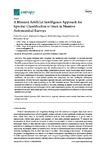| dc.contributor.author | Dafonte, Carlos | |
| dc.contributor.author | Rodríguez, Alejandra | |
| dc.contributor.author | Manteiga, Minia | |
| dc.contributor.author | Gómez García, Ángel | |
| dc.contributor.author | Arcay, Bernardino | |
| dc.date.accessioned | 2020-05-11T14:00:35Z | |
| dc.date.available | 2020-05-11T14:00:35Z | |
| dc.date.issued | 2020-05-01 | |
| dc.identifier.citation | Dafonte, C.; Rodríguez, A.; Manteiga, M.; Gómez, Á.; Arcay, B. A Blended Artificial Intelligence Approach for Spectral Classification of Stars in Massive Astronomical Surveys. Entropy 2020, 22, 518. https://doi.org/10.3390/e22050518 | es_ES |
| dc.identifier.issn | 1099-4300 | |
| dc.identifier.uri | http://hdl.handle.net/2183/25543 | |
| dc.description.abstract | [Abstract]
This paper analyzes and compares the sensitivity and suitability of several artificial intelligence techniques applied to the Morgan–Keenan (MK) system for the classification of stars. The MK system is based on a sequence of spectral prototypes that allows classifying stars according to their effective temperature and luminosity through the study of their optical stellar spectra. Here, we include the method description and the results achieved by the different intelligent models developed thus far in our ongoing stellar classification project: fuzzy knowledge-based systems, backpropagation, radial basis function (RBF) and Kohonen artificial neural networks. Since one of today’s major challenges in this area of astrophysics is the exploitation of large terrestrial and space databases, we propose a final hybrid system that integrates the best intelligent techniques, automatically collects the most important spectral features, and determines the spectral type and luminosity level of the stars according to the MK standard system. This hybrid approach truly emulates the behavior of human experts in this area, resulting in higher success rates than any of the individual implemented techniques. In the final classification system, the most suitable methods are selected for each individual spectrum, which implies a remarkable contribution to the automatic classification process. | es_ES |
| dc.description.sponsorship | This work was supported by Ministry of Science, Innovation and Universities (FEDER RTI2018-095076-B-C22) and Xunta de Galicia (ED431B 2018/42) | es_ES |
| dc.description.sponsorship | Xunta de Galicia; ED431B 2018/42 | es_ES |
| dc.language.iso | eng | es_ES |
| dc.publisher | MDPI AG | es_ES |
| dc.relation.uri | https://doi.org/10.3390/e22050518 | es_ES |
| dc.rights | Atribución 4.0 Internacional | es_ES |
| dc.rights.uri | http://creativecommons.org/licenses/by/4.0/ | |
| dc.subject | Hybrid systems | es_ES |
| dc.subject | MK classification | es_ES |
| dc.subject | Spectral features | es_ES |
| dc.subject | Astronomical databases | es_ES |
| dc.subject | Artificial neural networks | es_ES |
| dc.title | A Blended Artificial Intelligence Approach for Spectral Classification of Stars in Massive Astronomical Surveys | es_ES |
| dc.type | info:eu-repo/semantics/article | es_ES |
| dc.rights.access | info:eu-repo/semantics/openAccess | es_ES |
| UDC.journalTitle | Entropy | es_ES |
| UDC.volume | 22 | es_ES |
| UDC.issue | 5 | es_ES |
| UDC.startPage | 518 | es_ES |
| dc.identifier.doi | 10.3390/e22050518 | |






